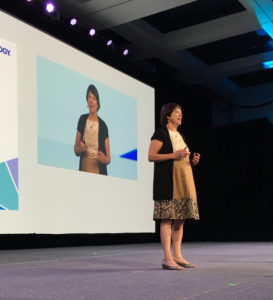“Adding qualitative research, which is highly sophisticated and structured, to quantitative research, is essential when we’re trying to make system changes to improve the health and safety of our patients,” said Karen B. Domino, M.D., M.P.H., at Tuesday’s John W. Severinghaus Lecture on Translational Science.
In her informative presentation “The Future Starts Here, With Cues From the Past,” Dr. Domino described the trajectory of her career as a qualitative research scientist and that field’s influence on perioperative care. She is an anesthesiologist at the University of Washington Medical Center, a UW Professor of Anesthesiology and Pain Medicine and Adjunct Professor of Neurological Surgery at UW in Seattle.

Karen B. Domino, M.D., M.P.H., at the John W. Severinghaus Lecture on Translational Science.
When deciding which medical career path to take as a resident, Dr. Domino was inspired by books, such as Experimental and Quasi-Experimental Designs for Research.
“I loved quasi-experimental designs for research, and I have a terrible rodent allergy. That clinched it. Outcomes research was for me,” she said.
For more than 15 years, Dr. Domino has been the director of the ASA Anesthesia Closed Claims Project, a registry of adverse health events – the kinds of experiences physicians hope they never see in their entire careers, such as postoperative blindness after closed spinal surgery or the delayed detection of esophageal intubation. The registry identifies safety concerns in anesthesiology, patterns of injury and helps to develop prevention strategies to improve patient safety.
“People think a registry is just a database. But it involves onsite review of medical and legal records, depositions and expert witnesses,” Dr. Domino said.
Data can be collected through interviews, observations, photos and document analysis. Qualitative research looks at emotional, social and cognitive phenomenon, and at patterns, themes and features. It’s iterative and flexible.
“Our anesthesiologists go onsite to do this work,” Dr. Domino said.
Gathering qualitative research data takes time, dedication and a massive multidisciplinary team effort. Analyzing the data can take a year or more. To get a better grasp, it helps to put it through a lens.
“I like to apply a theoretical framework,” Dr. Domino said.
The end result is a narrative summary that describes who, what, where and how “sentinel” adverse health events occurred. Qualitative data can complement quantitative research and result in program changes that can impact patient safety. It’s a winning combination.
“Embedding qualitative research into a mixed method design can lead to an effective way of interpreting the data,” Dr. Domino said.
It is a research method the NIH is embracing. The mixed research method can be used, for example, to determine why surgical safety checklists don’t work everywhere. In Ontario, Canada, 101 hospitals adopted them, but found no difference in operative morbidity or mortality.
“Without qualitative data, we won’t know why,” Dr. Domino said. “Conducting qualitative research has been an incredible addition to doing clinical care. It’s so great to be able to focus on doing research, but it can’t be done without inspiration, mentorship and support from your loved ones.”
Overall, big data can’t solve all problems.
“Words, texts and visual images are necessary to provide a better understanding,” she said.
Return to Archive Index